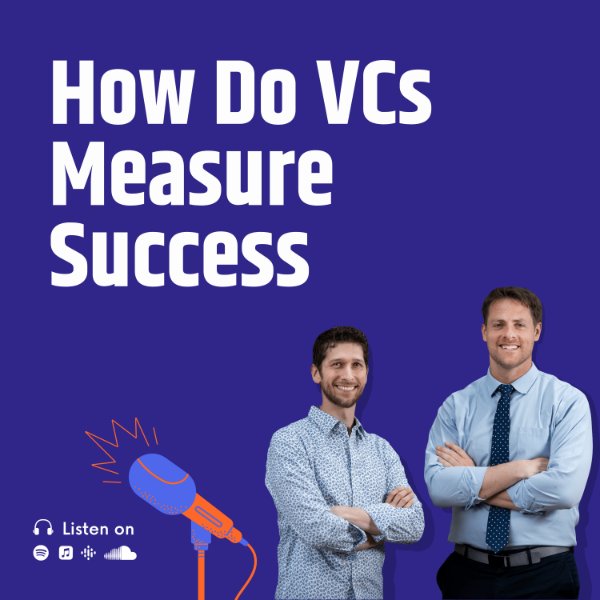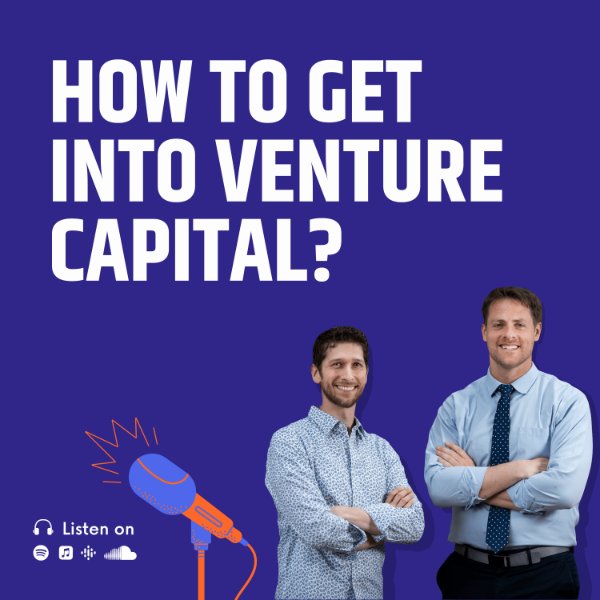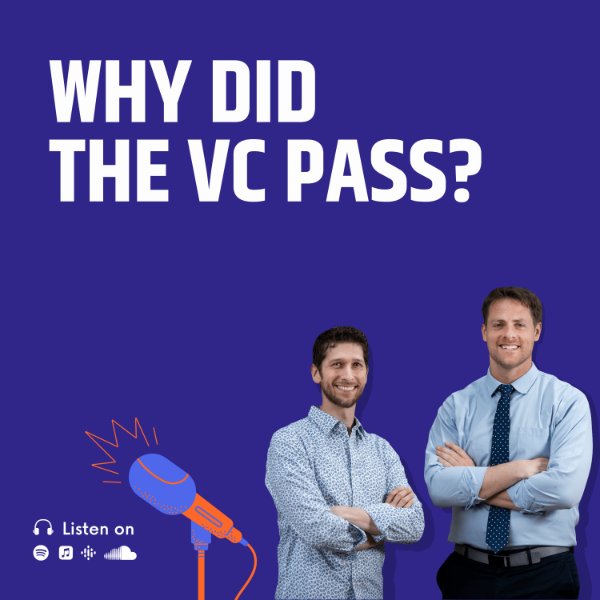Peter: Welcome, everybody to the Venture Capital podcast. Today, we're going to talk about some of the like big misconceptions or misunderstandings or things that maybe entrepreneurs don't fully appreciate.
Jon: And we're going to start by telling a story from YouTube on the Lesser as he likes to Go by. Created a company called Link, became an at some point went public. But at a certain point, the company got acquired before went public. And I think what is known or spoken about in the community without knowing the actual numbers is that he was the most successful entrepreneur from Utah who got paid the least.
Jon: And it's largely because he didn't understand some of the terms that we're talking about today.
Peter: Yeah. Yeah. So what happened in his case?
Jon: So my understanding is he didn't understand specifically what a liquidation preference is, and it might go a little bit bigger between common stock versus preferred stock that some stock is looked at very differently. And in Utah about 20 years ago when this happened, so it was a bit longer. It wasn't uncommon to have this term a liquidation preference, but it being a 7 to 12 x multiple of revenue.
Peter: Even even 20 years ago, that was a lot.
Jon: Well, so I don't know. I don't know his actual numbers, but I know back when I was working with a group called the Utah Angels, they're no longer around. Those were common terms. And then Silicon Valley entrepreneurs started coming to the state and really kind of portraying a light that these were hard money terms. Yeah. Yeah. But so those aren't happening.
Jon: Those terms still exist, but typically not to that extent. I think maybe three or four X might have been more common back then, and I don't know what the actual terms were. So.
Peter: So let's be clear. Like what a liquidation process.
Jon: And before we do this, we should do a preference that this is not legal advice, this is not finance advice. Contact your attorney or your lawyer. This is just us talking from our experience and understanding. This is educational purposes only. Always find professional advice.
Peter: Yeah. But hopefully these are the kinds of things that you should bring up with your attorney when you're fundraising. So, for example, liquidation preference. So what is the liquidation preference? Well, when a venture capitalist invests in your company, usually they're going to do it with preferred shares, right? You're going to set a new series of shares that will be preferred.
Peter: And part of the reason they do that is because it allows venture capitalists to tie certain provisions and rights to those shares. One of those that's extremely common is a liquidation preference, and it's designed really so that the investor gets their money back first before anybody else in the event of a liquidation. Usually when things go sideways.
Jon: A liquidation meaning if the company sells.
Peter: The company sells. Yep. And it could be even be like the company sells assets. Right. Like it's not a good outcome. So let's say, like, you raise $1,000,000 at a $9 million valuation, so they, the VC, ends up owning 10% of the company, and then the company doesn't do well and ends up getting acquired for like $5 million with a1x liquidation preference.
Peter: The VC is going to get their million dollars back and then the common and everybody else will split the remaining 4 million. So in that case, they're getting 20%, even though they only owned 10%, if that makes sense. That's what a liquidation preference is like from a very basic standpoint. Now, what happened in your story right, is that liquidation wasn't like a1x, The liquidation was like two, three, four, maybe even higher.
Peter: And so even though they had this great outcome for the company, the investors, you know, they took out so much money based on the liquidation preference that there wasn't a whole lot left for the common shareholders at the end of the day.
Jon: I mean, like an example of this would be, let's see, you took on 30 million investment and it sold for 100 million. And I think a safe term liquidation preference multiple would be three x. So the company sold 400,000,030 million was put in, The investors would pull out 90 million, you know, three times their investment and then there would only be.
Jon: Million left to split.
Peter: And even though you had $100 million exit. Right. And the investors, they just made three times their investment. So like, they're happy, you know, and they and the common doesn't get a whole lot left. Right. You know, I think the reality is those terms used to be a lot more common, both in Utah as well as Silicon Valley and New York, like on the coasts, everywhere.
Peter: But over time, like that power dynamic has shifted more in favor of the entrepreneur. And so it's very uncommon for you to see liquidation preferences that are above one X. Now, they do happen if the entrepreneur says, Hey, look, my company is really should be really worth a lot more than maybe the investors agree. And so what VCs will do sometimes they'll say, okay, fine, you want the really high valuation will give it to you, but we're going to add some structure, right?
Peter: And that structure could be a liquidation preference that's greater than one x, maybe it's two x or three x. So that that definitely happens. And and that's designed to compensate the investor for taking on some additional risk. Now, there there is a slight nuance to liquidation preferences that that you should be aware of and that is there is a participating preferred and there's a nonparticipating preferred.
Peter: So in a participating preferred, the way I think about that is you get your cake and you get to eat it too. So in that case, you get the gains on the investment, plus you get your money back first. So in a nonparticipating, you actually have to choose as the investor. So if I put in, you know, let's think about your example.
Jon: Let's go for easy, let's make it 70 million.
Jon: Free money. So it's 100 million Post-money okay.
Peter: So you own 30% of the business. Okay, So in that case, let's say the company sells for $100 million, right? In that case, you're indifferent. You either get you get your $30 million back because you own 30% of the business as the company sells for $200 million. In that case, you sell on 30% of the business, you'd get $60 million back.
Peter: Right. And so you have to choose. Do you want to keep your participant, your liquidation preference and take the $30 million or do you want to relinquish that and convert to common shares and get $60 million? Well, that's an obvious choice, right? You're going to convert to common. You're going to get the $60 million participating preferred. You get both.
Peter: So you get your $30 million back. Now there's $170 million to be split. Then you convert to Common and you still own 30% of that. So you're going to end up with, you know, it's like $51 million. So your total take is now going to be $81 million instead of $60 million.
Jon: What's the most common in today's investment?
Peter: So the most common is not to have any structure. Yeah. And the reason for that is that one you want to be you want to be entrepreneur friendly. And two, as an investor, what what investors have realized is that the same terms that they put on the company are the same terms that the next investor is going to want.
Peter: And once you've invested in the company, now you're like in bed with the entrepreneur or like you're really aligned. And so when somebody else comes in and they want the same terms ends up hurting you, and so you're like, generally it's best just to have what we call a clean term sheet, which is like a nonparticipating one x liquidation preference, a reasonable valuation, no crazy anti-pollution clauses and so on and so forth.
Peter: Like the more clean and simple it is, the better. Which, you know, that brings up anti-pollution clauses. Okay. So let's talk about another story I mean, this is years ago, but I remember meeting with this young entrepreneur and he had raised money at, I believe it was like a $20 million valuation. And the investors had put in what's called a full ratchet clause for antediluvian purposes.
Peter: So essentially what happened is the entrepreneur is like my companies are $20 million. The investors were like, now it's not. And he's like, Yes, it is. And they're like, Fine, we really like this deal. We'll give you the $20 million valuation, but we're going to put a ratchet clause in place if your next round you don't grow into that valuation and another investor comes in and says you're not worth 20, you're worth ten, then we want it so that our investment converts or there's more shares added such that it was as though we had invested at that $10 million valuation.
Peter: And what that essentially does is massively dilute all the common shareholders. And this parishioner is like in a really tough spot because he was like, you know, we raised all this money at that higher valuation. I'm going back out to market. I can only pull in a valuation that's half as much. And so that money is going to convert at that lower valuation, plus the money I need to raise.
Peter: And it's almost like completely wipe out all of the common shareholders. And my board is upset and I'm in this really tough spot. And I was like, I was like, that really is tough. Like, I you know, I don't know what to tell you for those that are listening, my advice is, in my opinion, you should always trade valuation for structure.
Peter: So what I mean by that is you should always take the lower valuation with less structure and more more of a clean term sheet than the other way around. Don't let your ego get in the way of things because you know, when things work out well, it structure doesn't matter. But the reality is things are most likely not going to work out well and it's ultimately going to hurt you the most in the relationship because VCs as is what we do day in, day out, like VCs, know how to play the game.
Peter: They know how to structure things much better than an entrepreneur does, is only going to raise money, you know, maybe two or three times in their entire lifetime. Just be thoughtful and be careful like clean term sheets. Way better at a lower valuation, way better than like really complex, structured term sheets that are higher valuation.
Jon: What's the trend right now? Tends to be cleaner.
Peter: for sure, 100%. Because I think.
Jon: If you're looking at the trend over the last five or ten years, like a like a convertible note came out. Yeah. Which there are very little terms. I mean if there's that there's like three or four terms, there's, there's a ceiling cap, there is the interest rate and then the, the, the discount. So like, let's say I don't know what standards the standard terms would be, There might be like it'd be like a, it'd be like a loan that might have like a 10% interest rate on it that may say, hey, if this company raises the next round at a $20 million valuation, we still come in at a five.
Jon: And then whatever that next round is, we're at a 20% discount. So and that was that is much cleaner than what was historically. But what is maybe what is the difference between a convertible note and the new the new document that's coming in now, a safe, a capital essay, f e.
Peter: So a save is a simple agreement for future equity, and it was developed by Y Combinator as a kind of a replacement for convertible notes because like convertible notes, I mean, they're a little bit wonky, they have some downsides to them and really like what you're when you invest in a save or you invest in a convertible. No, in a seed stage company, what you really want is equity, but you also want to kind of be top of stack and you want to you want to kick the can down the road on valuation.
Peter: And so a safe kind of helps you do a lot of those things. There's a lot of debate in terms of like are safes better than convertible notes? And I don't know that I want to jump into that whole debate here. But generally what you have with a convertible note, like you said, is you're going to have an interest rate that's usually paid in kind, which means you're not going to pay like cash on the interest rate.
Peter: It just means that when it converts, you're going to give up a little bit more equity. It'll have a cap so that when it converts, it won't convert any higher than what that cap is. And then it might have some discount rate. So when it converts, maybe if it doesn't hit that cap, it may have like a 20 or 30% discount to the next round.
Peter: And those are put in place to provide some incentive for investors to participate now when they don't really know what the valuation is, because as an angel like, you would not want to invest in the next, I don't know, like Facebook at, you know, when that's a bunch of guys and gals in a garage and you're taking insane risk and then they like knock it out of the park in the next round is like at $1,000,000,000 valuation.
Peter: And so you took all this risk, but you converted a billion, right? Like you'd want to have some caps in there so that like now maybe you convert it like 50 million or whatever it might be. It depends on the business. With a safe, it's a lot simpler. It's they're cheaper to use, frankly. Like you can just go to Y Combinator website and you can download the safe and you can make just a few little tweaks and then you just reference the safe back to the Y Combinator.
Peter: And you, frankly, in many cases like may not need an attorney, not legal advice, go talk to an attorney, always.
Jon: Talk to an attorney, but it might save you like 20,000.
Peter: But it might save you a lot of money. And that that's really the whole goal with it. Now, it's not truly a piece of debt. It doesn't have an interest rate. It doesn't have a few of these other mechanisms. There is some debate whether or not it actually puts you in a better position. If the company were to go south right, you may not get paid back first rate it.
Peter: It depends on in terms of where it sits in that that preference stack. But that's a general idea. It's just a really fast, easy, more affordable way to raise capital, especially if your your whole plan is in 6 to 8 months. We're going to raise a priced round.
Jon: Don't most VCs, though, have priced rounds versus safes? Like if if you're bringing on an investor, it's most likely going to be friends, families or an angel investor. I imagine you've never universally go for.
Peter: Somebody sizable investment. Say, have.
Peter: Verbal saves? Yeah, okay. And convertible notes.
Jon: Really, that kind of surprises me.
Peter: That now we've done it. I mean, at the end of the day, we don't want to be sitting on debt, we want to convert to equity. But sometimes that's I mean, you can find good deals that way. It just kind of depends.
Jon: At a friend who just raised from a local VC and we'll keep it. They won't mention who, what, who was or what it was, but I think they wanted to do a save. And in the VC is like, you know, we're just going to do a price around at a high seven figures.
Peter: Well then that probably worked out well for them then. Yeah. I mean there are tradeoffs for sure. I would say if you can do a price round and you can feel confident around valuation, then a price round is superior than a say for a convertible.
Jon: Now what are standard price rounds? Let's say you've got like three doves, no traction. What's a current priced round?
Peter: man. I mean, really.
Jon: What would be the the range of, I.
Peter: Don't know, like 3 to 10 million.
Jon: Per year to 10 million. Okay.
Jon: What would be the next big inflection point that might change that?
Peter: So if you're doing like probably the next big inflection point, it's going to be once you're doing about 1000000 to 2 million RR, in which case you're going to be 20 to 50 million. Okay. Depending on gross, I mean, it just depends on so many factors, but I'm kind of in that range.
Jon: Okay. Interesting. I hope you guys like that because most books never throw out numbers.
Peter: I mean, that's just what I'm seeing. And these numbers change, right? Like it wasn't that long ago that a series a round was priced at like 10 to 15 pre and now I'd say the average series A is priced closer to like 20, 30 or 40, especially the last like I mean, the last two months are a little bit of an exception.
Peter: But before that, like for like six, seven months like there were prices at like you know, 100, 200 or 300 million pre, I mean, just like crazy, crazy stuff because there's so much money chasing after deals. But I mean, look, those are unique deals where you've got a founder that's like been there, done that. They've got a crazy big idea huge market they've built an insane amount of FOMO right Like that's very different from like hey, I got this cool idea Me and my buddies, we're going to start something.
Peter: We crank on like an MVP in our garage and put it out there and start getting a little bit of traction. Like, those are two very, very different things. So but like, I think part of this too, is not everybody should raise venture money. In fact, like probably only like, I don't know, less than 5% of businesses in the US should actually be thinking about raising venture.
Peter: And yeah, because you know, once, once you get on the venture train, right, you got to keep fundraising, you got to keep growing. You're no longer like your your investors won't be happy with $100 million exit. They want $1,000,000,000 exit, right? And so when that $100 million exit comes along, you know, you're going to get a lot of pushback from your investors.
Peter: Like no, we're not going to make a big enough return on this. Like, it's a pretty crappy idea. Yeah. I mean, we're looking at a deal like in real time where the entrepreneur, you know, had an offer and the investors were like, no, like, well, we'll match the offer because we wanted to keep growing. Right? So and, you know, he, he gave up a decent chunk of change in order to keep pushing the ball forward.
Peter: Right. I know another entrepreneur that had a similar situation. He was like, nah, like, I'm only going to make a margin like marginally more and it's going to be so much more headache. And so he decided not to raise venture money and and he's looking to sell the company. So I mean, just be thoughtful around like what are your goals?
Peter: What matters to you when you're going through this this process? Right. And he thought like, get a really good attorneys, like somebody who does deals day in, day out. Don't get to like your uncle who like, you know, does like people's wills on the weekend. And when you get to them, like, don't be afraid to ask some and dig into like, questions and make sure you understand the terms that are being put across the table.
Peter: Because I guarantee you, like the VCs, the investors on the other side of the table, they know exactly what they're putting in there.
Jon: Yeah, when I think of Garrett, jeez, Exit of Skin. Stand up me to Sony. I know. Yeah, to.
Jon: Yeah. From SNAP. So. Yeah, but Sony had the documents that got leaked. Okay I think I might have to double check. But like when he, when he was telling me their story, how they were going through the exit, like their attorney was smart, their attorney said don't ask for this. Ask higher.
Jon: And your uncle or aunt.
Jon: Or you know sibling like you want someone who's been in the trenches. Yeah.
Peter: Or they may tell you to ask for more when it's totally inappropriate for you to ask for more and ends up killing the deal.
Jon: As it's called. We might have, but there's a local investor. Every time he wants to close the deal, the terms will be negotiated the last minute. It's the local Utah growth equity investor. You know what I'm talking about. All right. Yeah. Is that common or not common in growth equity?
Peter: It's not super common.
Jon: But it's common with that individual right or no for.
Peter: Yeah, I know that it's happened.
Jon: But yeah like these are and.
Peter: Doesn't look Yeah sometimes that happens right. And then like the play there is you get to the 11th hour or 59th minute the company is oftentimes like out of cash. Out of cash and then it's like and I want this extra little term and it puts the entrepreneur in a bind. So, I mean, that's a good reason why, you know, you should be doing your diligence on the investor that you're working with.
Peter: Right. And if they have a reputation for doing that sort of thing, that doesn't mean that you don't do a deal with them. It just means you better have a lot of money in your bank account if you're going to do the deal. So you have a.
Jon: Backup plan or you don't.
Peter: Have the 11th hour, are you going to be like, doesn't matter. I'm going to go find or.
Jon: Don't have a no shop clause? Or if there is a no shop clause, you may them make them pay for that no shop clause. So I think on that you're had that in their term right before the market crashed.
Jon: And I think was they put money in, they backed out because the market crashed and that's how they funded the company for the next year.
Peter: Yeah, that's another story that's interesting.
Jon: I need to go look at the backstory from John. What about control? As far as far as like the last term, that's commonly misunderstood.
Peter: Yeah. Look, so when I was when I first started in this industry, we went and had this meeting with like one of the top venture funds out there. And it was so interesting because they were like really transparent a lot of ways. And somebody asked a question around like control or, you know, valuation or ownership percentages and so forth.
Peter: And they were like, look, like when we're meeting with an entrepreneur, there's a lot of sensitivity around, like, I want to control my business. I want to own at least 51%, you know, all of these things. And they were like, you know, we never take majority positions in the companies we invest in. We're always taking minority positions. 1020, 30, 40% like, But in the docs, we're putting in provisions and blocking rights that essentially give us all the control we want.
Peter: You can't sell the company without our permission. You can't raise money without our permission. You can't hire somebody at a C-suite without C-suite level, without our permission. You can't add board members without our right. Like they say that you can't transfer shares or sell shares to someone else without our permission, right? So they put on all these terms so that like, yeah, you own 51 or 60 or 70 or 90% of your business.
Peter: But the reality is everything that matters, the VC has a say on and some control. Yeah. Some of that's kind of been loosened up over time. But what was interesting to me is like just how blatant the VC was is like, yeah, like they own most of the company, but at the end of the day we kind of still maintain control.
Peter: So it's another reason to be thoughtful, one about like the terms and understand like what what you're getting, what you're giving up, but also and understanding like the VC's reputation and what they're like to work with. Because sometimes you have those terms and they never get used, right? They're more in case of just a really, really bad divorce, essentially.
Peter: And then last is like decide a venture is really the game you want to play, right? Like you are going to give up control when you raise venture money. The flip side is you're going to gain time your most valuable resource, theoretically, because a VC can plow a ton of money in that can give you really fast growth.
Peter: That fast growth can attract more venture money and so you can grow your business really quickly, very big, and sell it for a big number in a relatively short time period versus trying to build it yourself. Right? It's a difference of like, do I build this business over the next like 20 years or I build this business over the next 5 to 7 and achieve the same outcome at the end?
Peter: One, you're going to give up a lot more control, but you're going to get it done faster. And the other like you'll maintain control, but it could take you a very long time to build it up to where where you want to get it.
Jon: Yeah, I think these are the most common misunderstood terms and 2022 for raising venture capital. It's like, agree with that, Peter.
Peter: I don't know if they're the most, but hopefully they're helpful as you're going about it so that you walk into the venture to the fundraising process a little bit more informed.
Jon: If there's other terms that you or questions to this video comment below if you're on YouTube and then we'll make sure we answer them on future episodes.
Peter: Awesome. Thanks for joining.
Jon: Us. All right. Thanks, guys.





